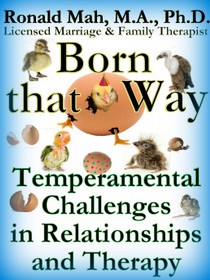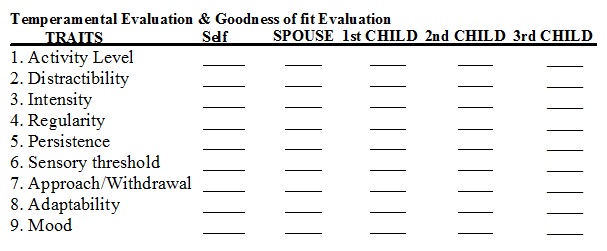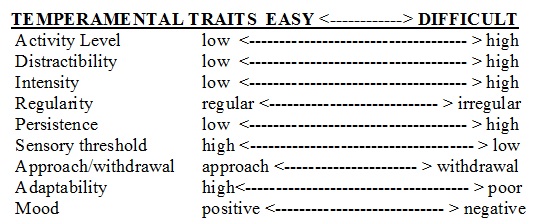1. Temperamental Traits - RonaldMah
Ronald Mah, M.A., Ph.D.

Licensed Marriage & Family Therapist,
Consultant/Trainer/Author
Main menu:
1. Temperamental Traits
Therapist Resources > Therapy Books > Born That Way- Termperament Rel

Born that Way, Temperamental Challenges in Relationships and Therapy
Chapter 1: TEMPERAMENTAL TRAITS
by Ronald Mah

Temperament has been studied and conceptualized by a number of researchers and professionals. The work of Chess and Thomas and the New York Longitudinal Study is the foundation for Stanley Turecki's child behavior book, "The Difficult Child" (1989). Temperament is conceptualized in the book as separated into nine dimensions or traits. Other researchers or theorists may have more or less traits and organize them or group them according to their theoretical frameworks. For example, "Fifteen temperamental dimensions offer a well differentiated set of attributes to describe positive and negative reactivity and self-regulation (Rothbart et al., 2001):


1. activity level,2. anger/frustration,3. attentional focusing,4. discomfort,5. fear,6. high intensity pleasure,7. impulsivity,8. inhibitory control,9. low intensity pleasure,10. perceptual sensitivity,11. positive anticipation,12. sadness,13. shyness,14. smiling/laughter,15. soothability (falling reactivity" (Teglasi et al., 2004, page 10).
Turecki follows Chess and Thomas' model of nine traits with each trait being bipolar with an individual ranging on most traits from high to low. In contrast to some other temperamental frameworks, the extreme high or low rating of any trait is not considered to be positive or negative per se. The value judgment of being positive or negative is not based on any trait or the profile of traits. Instead, the traits or profile are evaluated to see if they are more or less functional given the specific demands or requirements of the context: environment, task, family, system, etc. Thus, the fact of an individual who is high in activity level is neither good nor bad. High activity level may be an outstanding beneficial trait if the individual works in a physically demanding situation such as being a bike messenger. Conversely it could be a detrimental trait if the individual works on a computer in an office cubicle all day. High activity level is therefore not intrinsically good or bad; and low activity level is not intrinsically bad or good but more or less suited to the demands in given circumstances. Turecki calls two ends of the spectrum "Easy" and "Difficult" which references the ease or difficulty the individual encounters dealing with social and learning situations or circumstances. Yet, outside of such situations a so-called "difficult" temperament may be quite beneficial. Only the ninth trait uses value terminology of "Positive Mood" on one end of the trait spectrum versus "Negative Mood" on the other end. However, neither is automatically a "good" or "bad" trait. A positive mood or outlook on life can be arguably beneficial or harmful. For example, optimism can enable one to handle stresses and challenges well, but can also cause one to not duly note potential harm or dangers. On the other hand, pessimism can cause one to not note and appreciate positive experiences, but can also cause one to not take foolish risks. The following are the nine traits with short descriptive questions.
1. Activity Level: How active generally is the child/person from an early age?2. Distractibility: How easily is the child/person distracted? Can s/he pay attention?3. Intensity: How loud is the child/person generally, whether happy or unhappy?4. Regularity: How predictable is the child/person in his or her patterns of sleep, appetite, bowel habits?5. Persistence: Does the child/person stay with something s/he likes? How persistent or stubborn is s/he when wants something?6. Sensory threshold: How does the child/person react to sensory stimuli: noise, bright lights, colors, smells, pain, warm weather, tastes, the texture and feel of clothes? Is s/he easily bothered? Is s/he easily over-stimulated?7. Approach/withdrawal: What is the child/person's initial response to newness- new places, people, foods, and clothes?8. Adaptability: How does the child/person deal with transition and change?9. Mood: What is the child/person's basic mood? Do positive or negative reactions predominate?
The following is a worksheet for use in these evaluations. When looking at one person, it gives a temperamental profile. It can be particularly effective when used as a behavioral assessment as an alternative to the Attention Deficit Hyperactivity Disorder (ADHD) diagnosis with children. It can be expanded to be very effective to assess a couple's or a family's dynamic, or even a work team dynamic.


Turecki recommends a five-element program for working with children with difficult temperaments. They are suggestive for adult dynamics as well.
EVALUATION: The first step comes from defining the problem in terms of temperament. In some situations, temperament is a contributing factor in the dynamics, while in other cases it may be the dominant, core, or underlying issue. The professional should study the individual's behavior and the reactions from a partner, family, or group from the perspective of temperament versus making assumptions based on other perspectives. For example, an adult may perceive the child as oppositional and defiant or as the child as seeking attention inappropriately when considering the behavior as coming from discipline problems. Or, someone may perceive another person as insecure or anxious when viewing the person's behavior from psychological or emotional perspectives.
REGAINING ADULT AUTHORITY (with children): The parent, teacher, or other adult can do this by thinking in terms of temperament and dealing with behavior instead of responding emotionally or instinctively to what he or she perceives as the child's motives. As the adult learns to disengage, he or she can be more effective and purposeful in response. Disengagement is not disconnecting or rejecting the child. The adult instead seeks to become neutral in attitude, to think and evaluate before responding, to understand behavior as it is related to temperament, and to replace "Why is he or she doing this to me?" with "How can I understand his behavior?" This principle can be applied to the intimate relationship or some other group relationship as well. The pause to consider the underlying cause of behavior of another adult can prove beneficial especially if it slows negative reactive actions.
MANAGEMENT TECHNIQUES: Management is different from discipline. Discipline focuses on teaching more long-term behavioral lessons and principles of life. With an initial management approach, the focus is on handing the behavior in the present for safety and stability. Labeling, cooling off, helping with a sense of timing, dealing with change, eye contact, choices, introducing gradually, and understanding manipulative versus temperamental tantrums all can help the adult help the child or the partner help the other partner, or a colleague or supervisor help another employee. Since the individual's process or temperament is vital to his or her response, engaging in self-monitoring and understanding the other person are both important to management.
FAMILY GUIDANCE: With a very challenging or difficult child, member, or parent, families often need guidance to manage that person and their own reactions. Family therapy may be useful. This can be applicable to other systems such as at work or in the classroom.
SUPPORT GROUPS may also beneficial to interact with other challenged persons (parents or partners, etc.) and families (or groups) to gather support and insights for dealing with difficult individuals.
The five-element program when translated into the couple's dynamic must accommodate the explicit or implicit equality of the partners. Where Turecki's suggestions are based on the authoritative role and responsibility of the parent or parents, in the couple both partners need to take responsibility to work at being self-aware, adapt their behaviors, to observe, and give feedback or instruction to each other. This requires both partners to give permission for each other to give feedback and instruction. Permission gives both partners the authority necessary for the process to work. As a result, both partners can manage and self-manage with assistance any problematic behavior. The focus is on the behavior as not being productive versus one or the other partner being negative, insensitive, or some other harmful judgment. This may occur in couple therapy, or an individual can create this process with his or her intimate partner if he or she is not a part of therapy. Managing a similar dynamic in family empowers mutual feedback and a collaborative growth process. The therapist can initiate this process with a psycho-educational approach through information, readings, and/or taking the individual, couple, or family through a temperamental evaluation using a worksheet such as was just presented. Processing and discussing the client's interactions in therapy would be comparable to the family support and support groups in the five-element program for children.

